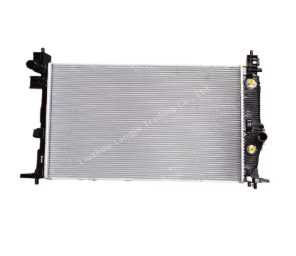Factorum Principales in Selectione Materiae Radiatricis
Conductivitas Thermica versus Ratio Ponderis
Quam bene radiator calorem conducit, magnum officium perficit in eius operatione universa, praesertim cum de movendo calore absque partibus ardentibus agatur. Radiatores qui calorem efficaciter conducunt, caliditatem multo melius diffundere possunt, quod in rebus celeriter refrigerandis plurimum valet. Cogita de carris celeriter currentibus aut machinis gravibus in fabricis sine intermissione operantibus. Ad haec usus, materiae ut cuprum et allumen praecellunt quod calorem optime ferunt. Plurimi ingeniatorum tibi dicent haec metalla prae ceteris eligi, etsi pretiosa sint, quia nihil aliud aequatur eorum facultati movendi calorem celeriter ac firmiter.
Quantum diversa materia radiatoria pondera pondera multum refert quando bona cum vehiculo designo perficientur. Cuprum valde bene conducit calorem sed habet dispendium quod plus ponderat quam aluminium. Pondus accessarium verum interest inter architectos automobilorum quia omnis libra refert ad efficaciam vehiculi in gaso et ad eius operationem generalem. Propterea pleraeque carae hodie radiatoribus aluminium utuntur. Aluminium etiam negotium perficit quoad calorem a motore removendum et id sine ulteriore pondere quod iacturam in litris carburantis faceret. Fabricatores automobilorum iam pridem hoc pactum inter conductibilitatem et pondus intellegunt.
Resistentia Corrosionis et Longevitas Materialis
Resistentia corrosionis est essentialis ad prolongandam vitam radiatrorum et minuendos sumptus maintenance. Potentia radiatris resistendi elementis corrosivis directe impingit in eius durabilitatem et frequentiam maintenance. Materialia velut ferrum inoxidabile et quaedam legamina aluminii laudantur propter resistentiam corruptionis excellente, ita praebentes vitam servicii longiorem.
Materiae diversimode respondent ad corrosionem, pro eo quod sunt factae. Aluminio exempli gratia, facile ad galvanicam et pitting corrosionem tendit, praesertim si contactum facit cum communibus refrigerantibus quae in applicationibus industrialibus utuntur. Alia est ratio cum aere. Hic metallum contra corrosionem ab aqua et oxygenio atmosphaerae resistentiam bene praebet. Numeri ostendunt, etiam si materiae cum bona corrosionis resistentia saepe magno initio impendio adiunctae sint, tamen in locis asperis diutius durare. Lucrum per annos servitutis accumulatur, quod facit ut tales materiae sint considerandae pro aedificiis quae cotidie cum constanti chemicae expositioni pugnant.
Implicationes Costus pro Diversis Materialibus Radiatoris
Costus materialium radiatoris pendet significative ab utroque initio manufacturae costibus et longe-termine parvitiis. Radiatores facti ex aluminio, dum sint viliores initio, fortassis postulabunt frequentiorem conservationem quam optiones maiore costu sed durabiles, sicut cuprum, impactantes efficientiam costus eorum in vita.
Cogitationes de materia afficitur variis rebus, sicut quomodo catenae supply funktione, et utrum quaedam elementa naturalia facile adiuvant an non. Aluminum saepe vilius est quia multum eius est et comparate simplex ad manufacturam, licet vidimus eruptiones pretii quando problemata sunt sufficientis materiae transfinis obtinendae. Secundum recentes studia mercatalis, plures homines sciunt de aequilibrio inter pretium et functione, sed in artificiis sicut aeronavis manufacturatio et currus productio, functio saepe vincit rationes pecuniarias quando eliguntur materiae radiatoriae pro vehiculis suis. Societates caute cogitare debent de expensas celeres versus quae conservabunt in via longa in manutenentia et partibus repurgandis.
Radiatores Aluminii: Levis Efficientia Refrigeri
Efficientia Dispersio Caloris Aluminii
Radiatores e alluminio iam facti sunt numerari inter instrumenta necessaria pro quacumque re quae multam refrigerationem postulat. Cur? Alluminium calorem ita bene conducit ut e motore celeriter abducat. Hoc significat motorem temperaturis tutis manere etiam cum diu vel in conditionibus difficilibus agitur. Cum mechanici materiales radiatorium in automobilebus tentant, alluminium semper antecedit quod celerius refrigerat et motorem a nimio calefaciendo prohibet. Hunc metallum fabricatores amant non solum propter motorem bene agendum sed etiam quod adiuvat prohibere dispendiosas disruptiones postea. Ab automobilebus cursus ad vehiculos onustos, mundus automotive iam ad radiatores e alluminio conversus est, et etiam artes mechanicae quae cum machinis calorem multum creant sequuntur exemplum.
Praeferentia Ponderis pro Automotivo et Electronica
Radiatores ex alluminio tantopere leves esse vere adiuvat architectos vehiculorum cum efficiens et bene in via vehicula aedificant. Cum fabricatores automobilorum ad alluminium praesertim admoveant, saepe pondera omnino minuunt. Haec constructio levis significat minus gas consumi et melius in curvis tenere. Quaedam experimenta demonstrant radiatores alluminiosos fere dimidium tantum ponderis eorum qui ex antiquis materialibus ut cuprum facti sunt, itaque idoneos pro emendationibus efficentiae reddunt. Non solum autem vehiculis haec utilia sunt. Multae societates electronicae ad alluminium confidunt pro refrigeratione, quia in locis angustis ubi componentes calorem generant sed spatium parum est, omnis grammo refert.
Risica Oxidationis et Commutationes Durabilitatis
Radiatores e alluminio certo bene operant, sed unum magnum defectum habent: quaestiones oxidationis quae durabilitatem eorum afficiunt. Cum alluminium cum oxigenio convenit, tegumentum protectivum in superficie formatur, sed ista stratum tempore dissolvi solet. Praecipuum autem est quod radiatores e alluminio, si compares cum aliis materialibus qui corrosionem melius resistunt, forsitan diligentiam frequentiorem requirant. Mecanici hoc saepe videre in systematibus refrigerandi automobilorum, ubi oxidatio tandem problemata creare potest, quae in onerosas refractiones aut deterius, systematis integri defectum ducunt. Tamen, plerique homines radiatores e alluminio eligunt quia praecipua commoda plerumque praeposita sunt negativis, modo quis eos proprie curet et signa oxidationis observet antequam magnae difficultates fiant.
Radiatores Ex Cupro: Excellentior Conductionis Thermicae
Virtutes Transfusionis Caloris Cupri
Radiatores cuprei vere antestantur cum de vehenda calore agitur quia optimē calorem conducunt. Numeros adhibeamus: cuprum calorem ducit ad circiter 385 watts per metrum kelvinum, aluminium autem vix attingit 205. Praxis magnam differentiam ostendit. Radiatores cuprei simpliciter calorem celerius movent quam alia omnia, quod bene explicat cur in systematibus refrigerandi ubi praestantia maxime valet ita bene functionent. Plures ingenarii quos per annos consului mihi eadem narraverunt: cuprum melius calorem gerit in iis rebus extremis ubi temperaturae ardent. Hoc est cur cupra componentia in omnibus generibus praeclarorum systematum thermicorum in variis industriae rami videmus.
Applicatio Gravis in Systematibus Industrialibus
Quando ad loca industrialia attinet, radiatores e aere tendunt ad optio praeferenda esse quia tantopere calorem regunt. Praeclarissime operantur in locis ubi rem frigere est valde necessaria, cogita de magno transformatoribus aut machinis gravibus quae sine intermissione currunt. Exempli gratia sumas systemata refrigerationis transformatorum. Sine idonea refrigeratione e radiatoribus aeneis, haec systemata laborarent ut optime operarentur quia multum caloris generant cum electricitas per eos fluit. Calorem conductio et translatio aerei eum praecipue commendat praeter alia materiae. Loca industrialia in hac proprietate confidunt ut machinae nimis calefactae interdum interrumpantur, quod operationes sine ruptis incedere iuvat.
Praemia Sumptuum et Requisitiones Conservandi
Radiatores cuprei certe meliores proprietates de transferendo calore habent quam radiatores ex alluminio, sed in fronte nobiscum est quod multo magis constent. Ad homines quaesitantes circum, haec differentia pretii multum refert cum de ratione cogitatur quae per tempus pecuniarum sit. Alia res est cura quae etiam consideranda est. Cuprum saepe plus attentionis indiget ut rostum vitetur, quod ad summam impensarum addit. Antequam decernatur, omnia computa videre iuvat ut intellegas an plus in cuprum impendere longo tempore solvatur, praesertim cum consideratur quantum laborem opus sit ut bene funtantur comparatis his quae viliora sunt.
Plastici Componentes in Design Radiatoris
Tanks Plastici pro Corrosionis Resistentia
Cum de ratione radiotorum agitur, vasi ex plastico praeclara sunt propterea quod valde resistunt corrosioni. Partes metallicae cito rubefaciunt in locis umidis, qua de causa totum systema minus diu manet nec tam efficaciter operatur. Plastica autem hoc malum non patiuntur, ideoque electio firma sunt in multis usibus. Fabricatores technologiam polymerorum recentissime multum emendaverunt, et hae emendationes vascula ex plastico ad rem texitas technicas refrigerandi etiam difficiles idonea reddunt. Exempli gratia, materies HDPE multo fortior evasit tempore et melius calorem sustinet quam antea. Hac de causa videntur bene operari etiam cum temperatus extremae sunt. Studia demonstrant conversionem e metallo ad plasticum systematis radiatoris usque ad duplicare aut triplicare posse tempus quo functionalis manet antequam mutandum sit.
Limitationes Expansionis Thermicae
Plasticae certo sua praesidia habent, praesertim quoad corrosionem repellendam, sed alia etiam habentur quae consideranda sunt. Dilatatio termica problema magnum est apud plasticas magis quam apud metalla. Cum temperaturis ascendunt et descendunt, partes plasticae magnopere mutant dimensiones, quod cum tempore radiatores laedere potest. Exempli gratia, cum subito caliditas augeatur. Plasticae celerius quam quis exspectet tumescunt, et haec tumescentia ad multa mala ducere potest, ut effusio per signa vel loca infirma in structura ipsa. Docti homines qui in hac re versantur monent bonam rationem habendam esse curam ut hae mutationes fiant. Hoc autem significat radiatores cum iuncturis flexibilibus et cum parvis zonis interpositionis ubi dilatatio naturaliter evenit construendos. Plurimi ingeniariorum confirmant se loca clavis muniunt, ut periculis termicis caveant et omnia constanter et firma maneant, licet temperaturae variantur.
Effectus Temperaturem Altarum in Integritatem Polymerorum
Cum plasticis in radiatibus diuturnis alti caloris periodis ictis sunt, firmitas eorum structurae incipit dissolvi. Continua caloris expositione materiae polymerae paulatim deteriorentur, quod tandem ad fatiscationem materiae aut plane ad defectum ducit. Multas industriae casus vidimus, ubi radiatores desinunt prope operari, quod plasticis intra eos quasi liquefactis sub extremis temperaturis, praesertim in situ ubi systema toto die vehementer premitur. Ut hunc defectum corrigamus, studiosi nunc operantur ad meliores polimerorum qualitates creandas, quae multo altiorem calorem sustinere possint absque forma aut functione amissa. Quae nova materia promittunt praeterea sunt durabilitas, quod cracarent vel distorquerent minus facile sub condicionibus vehementibus, quae in modernis radiatorum systematibus reperiuntur.

Impactus Materialium super Longevitatem Systematis Refrigirantis
Corrosio Galvanica in Radiatoribus Mixtorum-Materialium
Corrosio galvanica maxime fit problema in systematibus radiatoris ubi materiae diversae miscentur, et brevius tempus earum efficit antequam reficienda sunt. Quod hic accidit est scientia satis simplex: cum duae diversae species metalli se invicem tangunt in substantia conductiva sicut aqua vel liquido refrigerante, mala incipiunt evenire circa metalla involuta. Quod evenit? Maior degradatio et metallum ipsum disparit ex partibus. Hodie plerique radiatores combinant componentes aluminium et cupri, quod eos praecipue obnoxios facit huic generi damni. Visis commentariis mechanicorum qui hoc quotidie tractant, constat radiatores qui laborent propter galvanicas reactiones saepe citius quam exspectatum deficere. Cuiquam qui in designandis systematibus refrigerationis operam navat, oportet ut observet reactiones galvanicas potiales inter materiales si volumus systemata nostra per annos sine intermissione sineque continuas reparationes manere.
Stressus Thermicus Per Cyclum Inter Materialia
Alternatio continua inter calorem et frigus multum valet ad tollendum materiales radiatores, afficiens utrum bene operentur et quam diu durent. Cum calor augetur, materiae expanduntur, tum contrahuntur cum res refrigescunt. Haec alternatio structuram paulatim debilitat donec tandem aliquis defectus eveniat. Radiatores praecipue hoc patiuntur quod tot cyclis calefactivis et refrigerativis subiciuntur per totam vitam suam. Quod evenit? Rimae oriantur huc illuc, saepe etiam graves effusiones generantes si neglectae relinquuntur. Ratio huius rei inest in diversis materiales responsis ad mutationes caloris, metienda per id quod coefficient of thermal expansion dicitur. Experimenta in industria demonstrant quantum damni post saepius expositionem ad istas mutationes caloris accidat. Hac de causa prudentes ingeniarii multum operae navant in eligendis opportunis materiales et in systematis construendis quae istas tensiones melius sustinere possint, denique vitam radiatores in variis usibus producendo.
Comparatio Vitae Utilis: Systemata Aereum vs. Cuprum
Cum spectamus, quantum diuturna sint systemata radiatorium e alluminio atque cupro, magna dissimilitudo in earum praestationibus apparet. Radiatores allumini exiguam ponderis vim habent, calorem rite transferunt et contra corrosionem saepe optime resistunt, quae ex causis in variis artibus frequentissime adhibentur. Radiatores cupri aliam tamen rem ostendunt: calorem multo celerius ferunt et saepe diutius durant, licet plerumque cum onere aucto et maioribus impensis coniuncti sint. Experientia docuit utraque materia satis bene in longo tempore functionare, sed mechanici et ingeniarii saepe ad alluminum propter usum in carris confugiunt, quod ponderis minores partes in aedenda ratione peregrinationis et in regimine vehiculi magnopere iuvant. Plurimi, qui cum his systematis versati sunt, sentiunt electionem saepissime pendere ex conditionibus, quas radiator cotidie patietur: ex factoribus ambientalibus, extremis temperaturis et ex labore, quem sub onere sustinere debet.
FAQ Sectio
Quid sunt factorum clavium consideranda quando eligis materiales radiatoris?
Factorum claves includunt conductivitatem thermicam, rationem ponderis, resistentiam corruptionis, implicationes costis, et longevitatem materialis.
Cur aluminiolum saepe praeferitur in radiatores automotivos?
Alumen praefertur propter eius eximias proprietates dissipationis caloris, naturam leviorem et rationem conductivitatis-ad-pondus satisfactoriam, optimo modo utrumque refrigerationem et oeconomicam usum combustibilis.
Quomodo stress thermicus cycli afficit aetatem radiatatoris?
Stress thermicus cycli facit materiales expandi et contrahi, debilitando integritatem structuralem super tempus et potentia adficiens fissuras aut effusiones.
Quae sunt utilitates usus cupri in designe radiatatoris?
Cuprum offert thermicam conductivitatem praestantissimam, excellentes capacitatem transfusionis caloris, et durabilitatem, praesertim in applicationibus alto-performantia et industrialibus.

